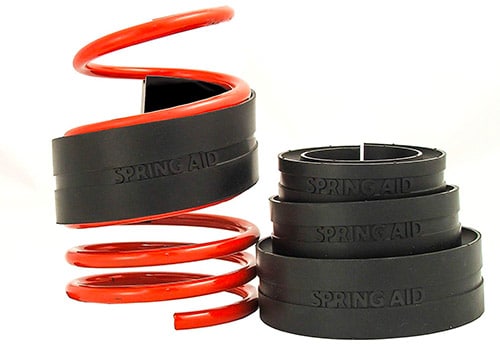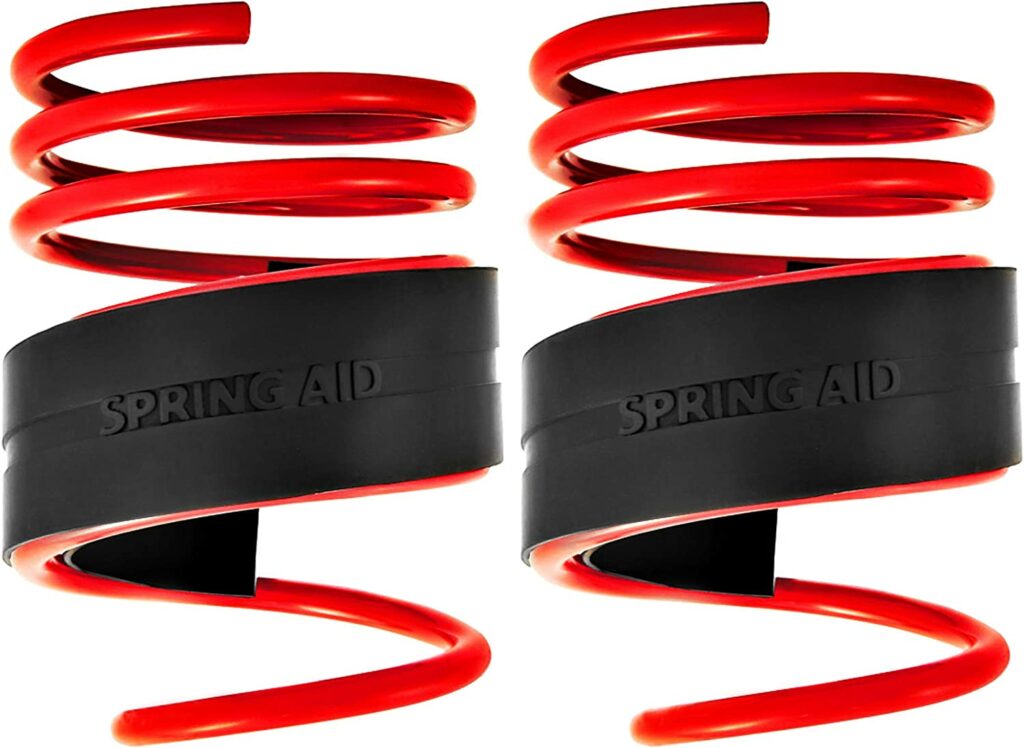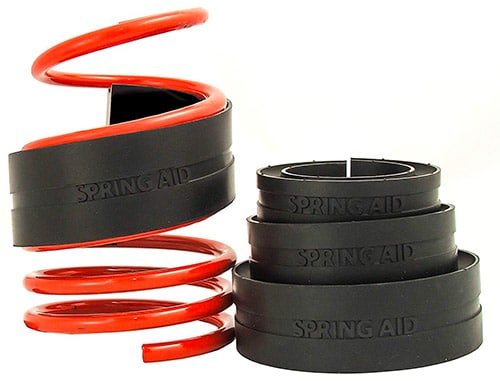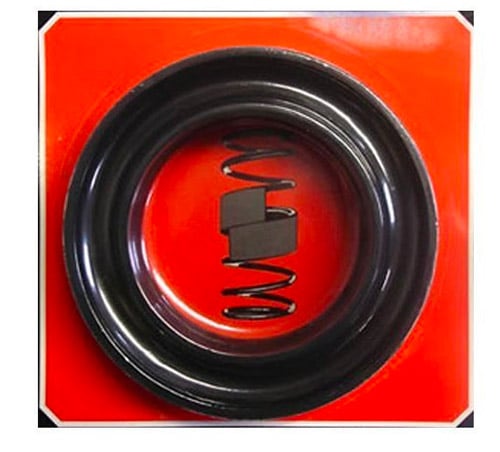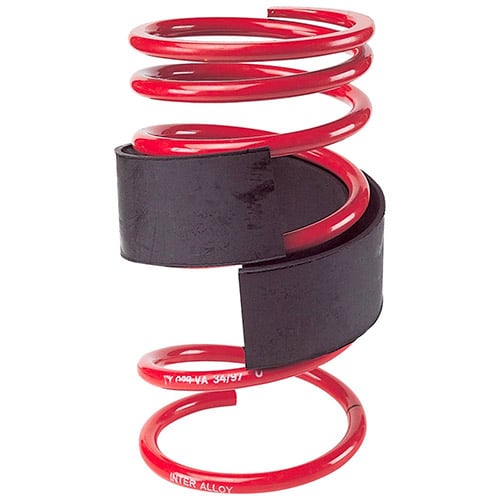Table of Contents
Spring Assisters For Your Caravan
The first product we want to look at briefly is the Spring Aid Gap Coil. This is ideal for providing the support a towing vehicle needs when it hooked up to a tourer. It also reduces the risk of your vehicle’s suspension springs bottoming out when you are driving on uneven surfaces to prevent damage occurring to either your caravan or towing vehicle. You will notice that the weight transfer is assisted too while you are under braking or accelerating. All in all, an affordable and useful assister, as long as your vehicle’s springs have a gap of 39mm to 51mm.
Next on our list is this set made from a durable and very tough rubber compound. There are no specialist tools required and therefore they can be installed by just about any average car owner. Designed for cars with a spring gap of 18mm to 25mm.
Back with Spring Aid for the next set. This is actually exactly the same as the other spring assister from Spring Aid, but is designed for car’s that have a spring gap of 18mm to 25mm. Very inexpensive.
From one of the leading names that manufacture this kind of car accessory, comes the 18 to 25mm coil from Grayston. It is made from a durable rubber compound like the others featured on our list and is ideal if you are planning on installing it yourself as it does not require any special tools or training.
Another fine and inexpensive item from Grayston, this is essentially the same product as the one above and the one below, just designed for vehicles with springs that have a gap size of 26 to 38mm.
Again, this is made by Grayston and this is the virtually the same product as the above two. It is made from the same rubber compound and helps to keep your vehicle level while you are towing a caravan, but has not been designed to hoister up a heavy load in the boot. The main difference between this one and others mentioned here is the fact that it is designed for vehicles with a spring gap in the suspension of 39 to 51mm.
Different Types of Spring Assisters
What you will find when you look at spring assisters is that there are various types out there. In the next section we will discuss some of these, including:
- Rubber Spring Assisters
- Coil Spring Assisters
- Inflatable Air Assisters
- Height-Adjustable Dampers
Rubber Spring Assisters
These are the most basic way you can upgrade your suspension. Rubber spring assisters are easily inserted in between the winds of the coal spring. They are also widely available and relatively cost-effective and provide more support for the spring, helping to reduce the effects of travel.
It is worth noting though that they can have a negative impact, if small, on the comfort of a drive, meaning your car could be a little bumpy when it’s tackling speed humps. You will be able to find rubber spring assisters in various thickness for different cars, but generally they are a fairly generic product compared to other types that are more specifically designed to certain makes and models.
Coil Spring Assisters
These are types of assisters that are installed around your car or tourer’s rear suspension components and work in combination with the existing spring. In their normal state, they are not under load and will have little to no effect on how well or not your car drives. Once you have a heavier load at the rear though, these assisters gradually provide extra help the existing suspension system, helping to reduce just how much it drops and stop it from bottoming out.
If you have a car that has a longer overhang at the rear, like many estate-style cars, coil spring assisters may the ideal choice. There are a wide variety of different fitments for both commercial chassis and cars. They are generally cost-effective, particularly when it comes to height-adjusted assisters (mentioned further down the page).
You need to be aware though that the installation of these kinds of springs will normally include a lot of dismantling of your suspension, it is best arranging for a skilled and experienced mechanic to fit them for you.
Inflatable Air Assisters
Another option to consider when it comes to spring assisters are inflatable air systems that can be fitted near or in the spring of the suspension. As you’d expect from the name, they correct the height of your vehicles by using compressed air. They are mainly used by motorhome users that have large lockers to the rear of the vehicle or motorcycle racking that can put a real strain on the suspension at the rear.
Height-Adjustable Dampers
By far the most commonly used height-adjustable dampers are those made by Monroe, like the Ride Leveller Kit. Dampers like that one has air chambers built into them. Inflated with compressed air, they provide support to the spring in the suspension at the damper mounting points. You will find that there are a number of different height-adjustable dampers available for applications. Commonly they are used with cars that have a long overhang or high load usage.
The thing to note about them though is that some trimming is required to get the ride height correct once a load has been applied. Although these systems are great for helping to maintain the driving characteristics of the car without a load to tow, their installation requires a valve being place at an accessible point and involves extensive pipework the car.
Conclusion
We hope that this page has been helpful and you are able to safely tow your caravan without it dragging along the road. For more information on anything else related to caravans, please check out some of our other fine posts here at Caravan Helper.
Due to their modern design and the technology involved, most cars can safely tow a caravan (of the right size) with no trouble at all. However, in the past, it was not always the case and car owners were regularly given the recommendation to upgrade the rear suspension. Even though there is no real need for spring assisters and other forms up rear suspension products for newer cars, there are still a number of them available cars and caravans that suffer from sagging rear axles when carrying a load.
If you have this kind of problem with your car or touring vehicle and are looking for a possible cost-effective solution, you’ve come to the right place. As well as looking at some of the best ones available on the market right now, we will first tackle some of the considerations you need to make before you actually invest in one.
It is crucial to contact the insurer of your caravan and car before you go ahead with any upgrade on the suspension. Although it is not likely, in most situations, that changes to the damper or spring will actually increase premiums, there are many insurance companies that will not allow these kinds of modifications.
It is also important that you realise that dampers and springs that have been upgraded will not actually raise the bearing limit of the axle or the hitch’s static load tolerance. In other words, the load you are able to carry in your touring vehicle or towing vehicle will not change, nor will the nose weight.
The main goal of using a spring or something similar is to ensure that the vehicle stays level while it is being towed and when it is static, instead of the front higher in the air and the rear dragging closer to the ground. This is vital in particular for cars with front-wheel drive as having a lower load on the front can lose a lot of traction.
Manufacturers spend a lot in terms of money, time and effort to design and build suspension systems on the chassis of their vehicles that meet the specific driving characteristics that suit the target audience for that make and model.
With that in mind, you need to be careful when making changes to bushes, dampers and springs because those changes could affect the way the car acts when it is driven. For instance, installing stiffeners into the suspension system can create a trade-off between the stiffness of the drive when there is no load and the improved stability it has while it is towing a load.
The most important thing we feel here at Caravan Helper that you need to remember is that any upgrades you make to the suspension of the towing vehicle or your tourer will not actually correct any fault present. If there is an actual fault, you should not use any upgrades, like assisters or dampers to fix it. Any worn parts should, ideally, be replaced. Additionally, it is worth noting that weaknesses in the components of some suspensions can cause excessive wear and tear on tyres that should be looked into thoroughly and fixed before you upgrade your suspension.
